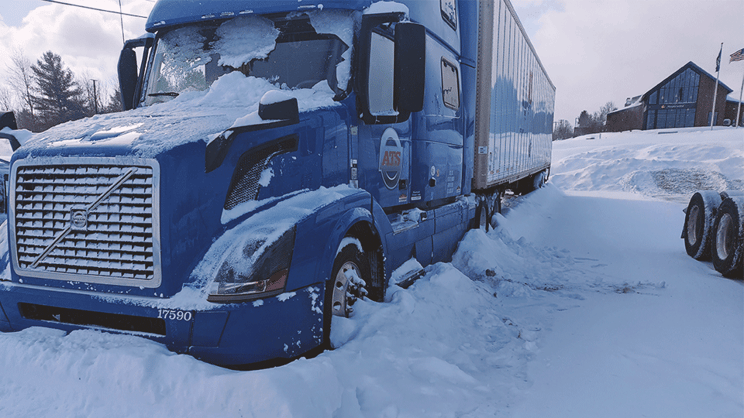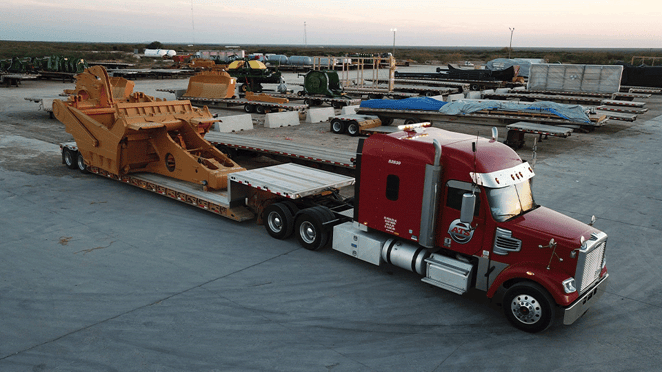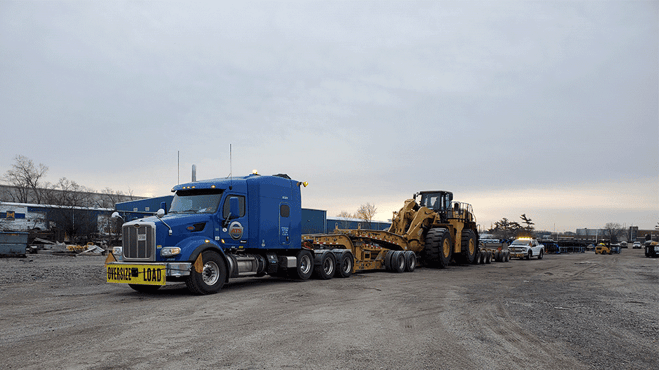As winter fades and spring takes hold, the freight market undergoes seasonal shifts that can impact your supply chain.
From produce harvests driving up reefer demand in the South to frost laws restricting over-dimensional (OD) freight movement up North, March presents both challenges and opportunities for shippers.
Anderson Trucking Service (ATS) has been in the transportation industry for 70 years. During that time, we’ve seen the seasonal ebbing and flowing of the freight market — so we know what to expect in early spring.
Understanding these trends can help you optimize costs, secure capacity, and avoid last-minute surprises.
In this article, we’ll break down what you need to know about dry van and reefer capacity, open-deck availability, and OD freight movement — plus provide key strategies to help you navigate March successfully.
Whether you're looking to mitigate rising rates, avoid capacity crunches, or simply make the most of this month’s freight trends, this guide will help you stay ahead of the game. We’ve broken down our market insights by trailer type for your convenience:
- Dry van and reefer capacity
- Open-deck capacity
- Over-dimensional (OD) capacity
- How to get the most from your supply chain this month
How Will Dry Van and Reefer Capacity Change in March?
Both in the U.S. and around the world, dry van trailers are constantly moving. Whether it’s the uptick in retail freight movement brought on by December’s holiday rush or household goods season in the summer months, there’s never a shortage of demand for enclosed trailers.
In March, produce harvest begins to ramp up in the southern states, raising the demand for dry van and reefers in the process.
The perishable nature of commodities harvested in states like Florida, Georgia, and Alabama during March (think oranges, grapefruit, radishes, and peas) necessitates quick and reliable capacity supplied by dry van and reefer trailers.
With the spike in demand from harvesting states, van and reefer drivers tend to congregate in the southern half of the country in March.
As a result, securing capacity in other regions, like the upper Midwest or Northeast, could require a bit more lead time this month.
That said, this change in the national dry van market can benefit the companies that take advantage of it.

Pay attention to weekly market updates. As southern portions of the U.S. become increasingly hot for dry van demand, plan out your loads into these areas.
Your transportation provider — knowing it will be sending its trucks to a high-demand endpoint where it will be easier to find another load — will be more likely to price your shipment at a relaxed rate.
On the flip side, if your supply chain utilizes van or reefer trailers in and around spring produce hotbeds, it may be more expensive to secure that capacity this month.
How Will Open-Deck Capacity Change in March?
Unpredictable weather, cold temperatures, and slick roads can keep open-deck truck drivers from wanting to haul in northern regions in the winter — and yes, for many northern states, March is very much still wintertime.
Tarping open-deck loads is time-consuming and labor-intensive even in the mildest weather. When blistering cold and stiff winds enter the picture, many drivers would simply rather not haul these loads.
So, there’s the rub: either shippers make it worth drivers’ while to tarp in winter weather (read: pay a great rate) or find another way to protect their loads during transit.
If you’re not interested in paying more to move open-deck commodities that require tarping this month, you do have alternatives to tarping.
For example, using high-quality shrink wrap is a common way shippers avoid tarp-related price hikes while maintaining the safety and integrity of their freight. When factoring in the additional costs and risks associated with tarping, shrink wrapping can often pay for itself in the long run.
Opting for a different trailer type, such as a Conestoga, is also a viable alternative to tarping. If your freight must be protected from the elements but isn’t limited to open-deck trailers by its dimensions, you may prefer to move it in a Conestoga, curtain-side, or even dry van trailer.

Just keep in mind that specialized trailers like Conestogas are harder to come by, which usually makes them more expensive. Compare those rates with what you’d pay to move a tarped open-deck load before making your final choice.
Additionally, March is the time of year when the construction and agriculture industries often begin needing more open-deck capacity.
While this ultimately depends on the (somewhat unpredictable) timing of spring thaw, don’t be surprised to see these industries adding to demand and limiting the overall market supply of open-deck trailers.
To ensure that your open-deck shipments are moved in as cost-effective a manner as possible, prioritize lead time on each load. Work with your transportation provider to pre-book capacity, and be flexible on your pick-up and delivery windows.
The easier you can make it for truck drivers to service your freight, the better off you’ll be this March.
How Will Over-Dimensional (OD) Capacity Change in March?
In March, the onset of spring thaw slows the movement of over-dimensional (OD) freight in the northern states. Spring thaw causes progressive weakening of roadways due to the cycle of melting and freezing that occurs as the temperatures warm.
Seasonal road restrictions called frost laws help to protect these weakened roads by placing stricter limits on the movement of OD freight, as these loads are more likely to cause damage due to their weight.
(Though it should be noted that frost laws can impact legal loads, too — it just depends on the specifics of the restrictions for that roadway.)
Frost laws usually take effect in the last few weeks of March, though exact timing depends on the jurisdiction in question.
In fact, everything about frost laws is up to the county, state, or federal jurisdiction that owns the affected roads. Frost laws are not universally mandated, and there are no general guidelines for how long they may be in effect.
This can lead to confusion, as a load may travel a route on which frost laws are active in some jurisdictions but not in others.
Failure to consider the impact of area frost laws can have a negative effect on your supply chain. Prepare for them by consulting a trusted transportation provider about your OD freight now.
If you have questions about what, if any, road restrictions will impact the movement of your shipments in the coming weeks, make sure they’re thoroughly answered. The last thing you want is to have a shipment re-routed due to a lapse in planning or because you relied on an under-informed transportation provider.

As far as securing OD truck capacity goes, lead time will be important in March. Agriculture machinery and construction equipment is now moving more regularly as field prep, road work, and building construction revs up for 2025.
These industries and types of projects can claim a large portion of heavy haul capacity this month, so be sure to factor in the increased demand and give your carriers more lead time than normal.
3 Ways to Get the Most From Your Supply Chain in March
Now that you understand some of the transportation market’s driving forces during March, let’s talk about making the most of your budget.
In the spirit of maximizing your transportation savings, here are three of the most impactful things to prioritize during the third month of the year:
- Avoid rigid appointments
- Plan around the quarter-end surge
- Stay informed and plan accordingly
#1: Avoid Rigid Appointments
Although a little flexibility goes a long way during most every time of year, it will be all the more important in the coming weeks.
Truck drivers are subject to a strict set of regulations governing the time they’re allowed to be actively on duty within a 24-hour period. These rules, known as hours of service (HOS), limit drivers to 14 hours of “on-duty” time per day.
Since drivers only make money while they’re moving freight, their 14 hours (of which only 11 can be used for driving) must be allocated wisely. The more unforgiving an appointment time is, the harder it becomes for transportation providers to schedule their trucks most efficiently.
That means insisting upon a strict 8 a.m. pickup time will affect your freight rates, as drivers will want a better rate for the inconvenience — especially when harsh weather conditions make staying on schedule all the more difficult.
Instead, you’ll be better served by allowing a wider arrival window, such as between 8 a.m. and 10 a.m.
This gives your transportation provider the flexibility to plan their truck’s journey to your door (and the driver’s remaining HOS) more freely — likely saving you money in the long run.
Related: 4 Out-Of-The-Box Ways To Save Money On Your Freight Rates
#2: Plan Around the Quarter-End Surge
The final week of any month is a busy time for businesses. But March also marks the end of the first quarter (Q1) of the year, making it an even more critical period.
With shipper inventories needing to move before quarter’s end, it’s not uncommon for the trucking industry to experience short-term capacity crunches in the waning days of March.
Don’t let this surge take you by surprise. Let your transportation providers know your end-of-month/quarter needs as far in advance as possible.
This allows your provider to plan out your trucks and will position you to avoid the price hikes that can accompany an end-of-quarter scramble for capacity.
#3: Stay Informed and Plan Accordingly
There is a laundry list of market updates and analysis tools available for shippers to use throughout the year. Leverage this information as the market fluctuates, rates change, and various seasonality surges begin, so you can manage your supply chain most effectively.
Although you can get updates from your transportation providers directly, many shippers find value in the insights provided by companies like DAT Freight & Analytics and FreightWaves.
Subscribe to the updates these companies and their peers produce and frame your strategy around them.
Jostling for transportation capacity in a fierce market — particularly on short notice — can drive a shipper’s rate sky-high. Making educated planning decisions by using insights provided by industry experts will help you make the most of your supply chain this month.
Make Smart Moves in March and Beyond
March brings seasonal shifts that impact freight capacity across trailer types. Whether you're navigating increased reefer demand in the South, dealing with open-deck pricing challenges, or planning around frost laws for OD freight, strategic planning is key.
By remaining flexible with appointment times, anticipating the quarter-end surge, and leveraging market insights, you can keep your transportation costs in check and avoid unnecessary disruptions.
That said, even the best-laid plans can be derailed if you're working with an unreliable carrier. Ensuring your freight moves safely and efficiently starts with proper vetting. Not sure what to look for?
Download our Carrier Vetting Guide for free today to learn how to identify trustworthy transportation partners and avoid costly mistakes. It’ll help you make sure your network is full of companies you can rely on all year round.


